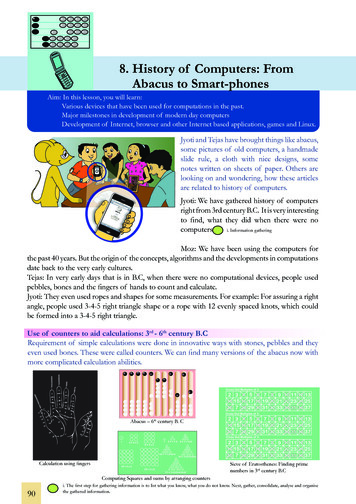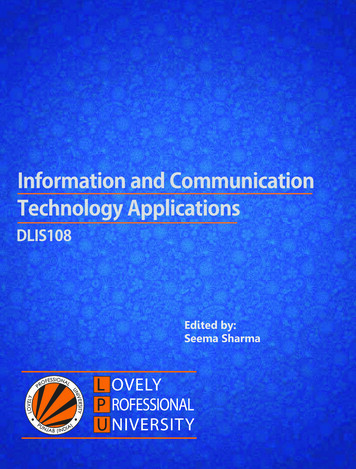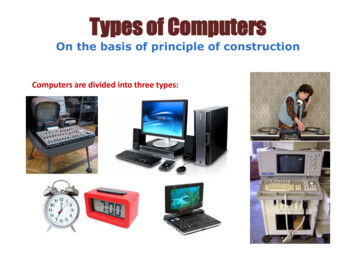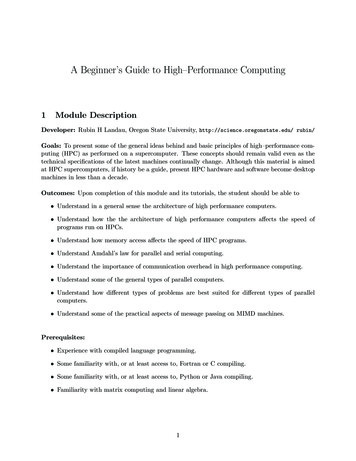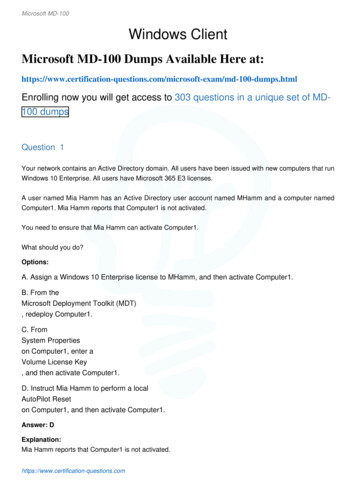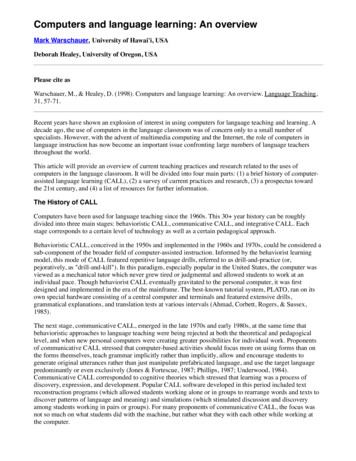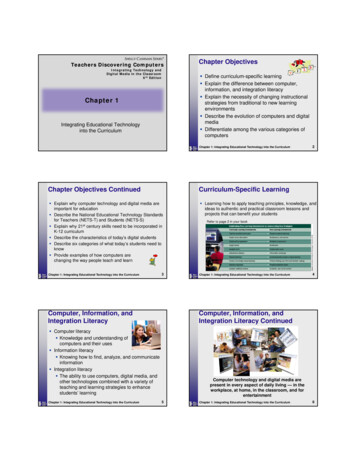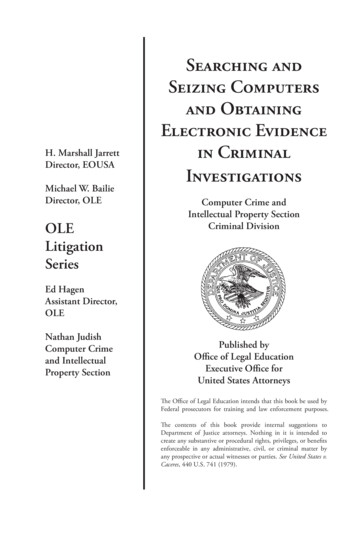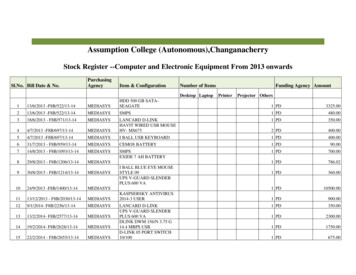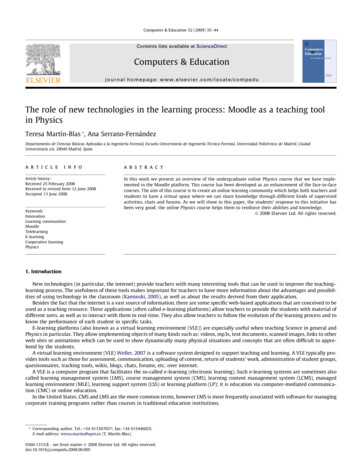
Transcription
Computers & Education 52 (2009) 35–44Contents lists available at ScienceDirectComputers & Educationjournal homepage: www.elsevier.com/locate/compeduThe role of new technologies in the learning process: Moodle as a teaching toolin PhysicsTeresa Martín-Blas *, Ana Serrano-FernándezDepartamento de Ciencias Básicas Aplicadas a la Ingeniería Forestal, Escuela Universitaria de Ingeniería Técnica Forestal, Universidad Politécnica de Madrid, CiudadUniversitaria s/n, 28040 Madrid, Spaina r t i c l ei n f oArticle history:Received 25 February 2008Received in revised form 12 June 2008Accepted 13 June 2008Keywords:InnovationLearning communitiesMoodleTelelearningE-learningCooperative learningPhysicsa b s t r a c tIn this work we present an overview of the undergraduate online Physics course that we have implemented in the Moodle platform. This course has been developed as an enhancement of the face-to-facecourses. The aim of this course is to create an online learning community which helps both teachers andstudents to have a virtual space where we can share knowledge through different kinds of supervisedactivities, chats and forums. As we will show in this paper, the students’ response to this initiative hasbeen very good: the online Physics course helps them to reinforce their abilities and knowledge.Ó 2008 Elsevier Ltd. All rights reserved.1. IntroductionNew technologies (in particular, the internet) provide teachers with many interesting tools that can be used to improve the teaching–learning process. The usefulness of these tools makes important for teachers to have more information about the advantages and possibilities of using technology in the classroom (Kaminski, 2005), as well as about the results derived from their application.Besides the fact that the internet is a vast source of information, there are some specific web-based applications that are conceived to beused as a teaching resource. These applications (often called e-learning platforms) allow teachers to provide the students with material ofdifferent sorts, as well as to interact with them in real-time. They also allow teachers to follow the evolution of the learning process and toknow the performance of each student in specific tasks.E-learning platforms (also known as a virtual learning environment (VLE)) are especially useful when teaching Science in general andPhysics in particular. They allow implementing objects of many kinds such as: videos, mp3s, text documents, scanned images, links to otherweb sites or animations which can be used to show dynamically many physical situations and concepts that are often difficult to apprehend by the students.A virtual learning environment (VLE) Weller, 2007 is a software system designed to support teaching and learning. A VLE typically provides tools such as those for assessment, communication, uploading of content, return of students’ work, administration of student groups,questionnaires, tracking tools, wikis, blogs, chats, forums, etc. over internet.A VLE is a computer program that facilitates the so-called e-learning (electronic learning). Such e-learning systems are sometimes alsocalled learning management system (LMS), course management system (CMS), learning content management system (LCMS), managedlearning environment (MLE), learning support system (LSS) or learning platform (LP); it is education via computer-mediated communication (CMC) or online education.In the United States, CMS and LMS are the more common terms, however LMS is more frequently associated with software for managingcorporate training programs rather than courses in traditional education institutions.* Corresponding author. Tel.: 34 913367657; fax: 34 915446025.E-mail address: teresa.martin@upm.es (T. Martín-Blas).0360-1315/ - see front matter Ó 2008 Elsevier Ltd. All rights reserved.doi:10.1016/j.compedu.2008.06.005
36T. Martín-Blas, A. Serrano-Fernández / Computers & Education 52 (2009) 35–44In the United Kingdom and many European countries the terms VLE and MLE are used more frequently; however, these are two verydifferent things. A VLE can be considered a subsystem of an MLE, whereas MLE refers to the wider infrastructure of information systems inan organization that support and enable electronic learning.There are many e-learning platforms kb.shtml. Some of them are commercialsoftware, whereas others are open-source software (OSS). Among the first category are WebCT and blackboard http://www.blackboard.com/us/index.bbb (that merged in 2005). Examples of open-source platforms are Moodle http://moodle.org/, Ilias http://www.ilias.de/, Atutor http://www.atutor.ca/ and Claroline http://www.claroline.net/. All these applications have common features, but someof them are more flexible and complete in specific aspects, such as role assignments, chats management, etc.The Universidad Politécnica de Madrid (UPM) (http://www.upm.es) has placed at lecturers’ disposal the Moodle platform to developonline courses proposed as a complement to the classroom lessons. Development of Moodle is undertaken by a globally diffused networkof commercial and non-commercial users, spearheaded by the Moodle Company based in Perth, Western Australia, although its originaldeveloper is Martin Dougiamas (http://dougiamas.com/). One of the most striking features of the design approach favoured by Moodleis the ease with which course materials can be developed and refined in an iterative fashion (Berggren et al., 2005).The University brings professors technical support and also manages the students’ database. Taking advantage of this opportunity, wehave implemented in Moodle an undergraduate Physics online course as an extension of the face-to-face courses. Our aim is to providestudents with additional material (web-based homework) that helps them to deep into the concepts and subjects developed in theclassroom.In this work, we show the main features of our online Physics course (implemented in Moodle) as well as the conclusions derived fromthis experience. First, we will introduce a description of the main features of our online Physics course. Then, we will examine the resultswe have obtained, and the students’ response to this initiative.2. BackgroundMoodle has been used as a LMS platform for sharing useful information, documentation, and knowledge management in research projects, yielding important benefits to the researchers (Uribe-Tirado, Melgar-Estrada, & Bornacelly-Castro, 2007). Data mining techniqueshave also been addressed as complementary systems to LMS, and in particular to Moodle, where results are achieved through the useof associators, classifiers, clusterers, pattern analyzers, and statistical tools (Romero, Ventura, & García, 2008). The transition from commercial LMS to open-source systems (such as Moodle) is a growing trend. The spread of these online technologies has been widely analyzed atfaculty level, as for example in San Francisco State University (SFSU), where the 70% of all courses use online technologies (Beatty & Ulasewicz, 2006). Moodle platforms are under continuous evolution. Different debates and forums are being set up in order to maintain an opendialogue between lecturers and Moodle developers. The achievement of a transparent integration between both ‘‘worlds” is needed for future versions (Berggren et al., 2005).Teachers can also improve Moodle platform by implementing web-based peer assessment. These works are used to enhance the studentcognitive schema, helping them to construct their knowledge, and promoting the student positive attitudes towards discussing and cooperating with peers. It is evidenced that students increase their skills to undertake learning by using the information technology.The usage of computers in Physics instruction began in the seventies (Chonacky, 2006). Since then, there have been many studies thatanalyze the effectiveness of new technologies applied to teach Physics (for an extensive revision of these results, see for instance (Kenny,Bullen, & Loftus, 2006).There is a wide debate about the influence on computer-assisted education in Physics courses (Kenny et al., 2006). Some authors consider that computational Physics provides a broader and more flexible education than a traditional Physics course. Moreover, they considerthat teaching Physics as a scientific problem-solving paradigm is a more effective and efficient than using the traditional approach (Landau,2006).3. Materials and methodsIn Moodle, all the available information within a course (for a specific subject) is organized in separate blocks. The first block is alwaysdevoted to general and administrative information, as well as support contents about the course: timetables, teachers, news, forums, chatsand so on. The remaining blocks can be organized in different ways. In our course, each block corresponds to a specific area of the subject.We have organized it as follows:- First and second block: teachers, timetables, general forum, chats (one for each teacher), exams, lab description, course planning, homework (see Fig. 1).- Third block: kinematics, single-particle dynamics- Fourth block: many-particle dynamics, rigid body- Fifth block: electrostatics- Sixth block: magnetism- Seventh block: thermodynamics.This syllabus is the same as the one distributed the first day of class, so there is no difference between the CMS-oriented syllabus and theone used during the face-to-face course.Chats and forums added to the first block are conceived as an online space for discussion and a real-time source of information andnews. First, students have up-to-date information about the different activities they have to carry out in order to follow the course, i.e.lab sessions, support lessons. On the other hand, they can post questions and begin a debate about doubts and concepts learnt in theclassroom.
T. Martín-Blas, A. Serrano-Fernández / Computers & Education 52 (2009) 35–4437Fig. 1. Physics online course first block’s screenshot.The course planning is a section that we update each two weeks. There, we post the contents that will be developed in the classroomduring that period, as well as the problems and exercises that we will solve during the same period. This way the students can know inadvance which concepts are going to be treated in the classroom, so they can read about them and they can also try to solve the problemsby themselves before they attend the course. It is also very useful for students that did not pass the exam in previous years and want to putthe stress only on specific concepts.In the homework section, we propose some out-of-classroom activities. These activities consist of a series of problems related to theconcepts explained during the lessons. We then correct them and we give them back to the students so they can improve the aspectsof the problem that posed more difficulties to them. The idea is to follow the performance of the students from the beginning to theend of the course.Besides chats and forums, we have chosen the following items from the different course material elements that can be implemented inMoodle, in order to include them in each theme block (see, for instance, Fig. 2).-Quizzes with different kinds of questionsCollections of problems and exercisesLecture notesJava applets.
38T. Martín-Blas, A. Serrano-Fernández / Computers & Education 52 (2009) 35–44Fig. 2. Screenshot of the first theme block.3.1. QuizzesQuizzes are a useful tool for students to test their level of knowledge. All the questions posed there are based on basic concepts of Physics previously explained in the classroom. Moodle provides a wide range of quiz types. For our online course we have chosen questions thatcan be of two types: true/false and multiple-choice questions. Apart from the questions themselves, there are many parameters one canadjust in the quizzes: the date at which the quiz is available, the time they have got to solve it, the number of tries; with the wrong answersthe teacher can send a comment to the student. They know the score they have gotten in real-time. When a quiz is created, one can definethe number of tries one student can do. Students can therefore try again when they think they have improved the knowledge they have onthese issues. Each time the students try to solve one of them the questions appear in different order. In the following figure (Fig. 3) anexample of a true/false quiz item is shown.3.2. Collections of problems and exercisesOne crucial aspect of the process of learning Physics is to develop the ability to solve problems that represent different (more or lesscomplex) physical situations. Students usually find it difficult to apply the laws and equations they have seen in the classroom, so it isimportant to provide them with a collection of exercises that help them to accomplish this task. For this reason, we have uploaded to Moodle a complete set of problems, ranging from mechanics to thermodynamics.3.3. Lecture notesWe are aware of the fact that there is a large amount of good bibliography on undergraduate Physics; however, we think it is also usefulfor the students to have a collection of lecture notes on this subject. In these notes we can put the stress on specific issues that we findparticularly hard to assimilate by them, based on our own experience of more than ten years teaching Physics. On the other hand, as manyof the students work and study at the same time and cannot attend all lessons, by means of these notes they have a way to follow andprepare the course, even while they cannot attend them for short periods of time.3.4. Java appletsPresentations in a standard format (such as scripts, Java applets, movies and flash animations) are an excellent tool to understand thelaws of Physics by means of dynamic simulations of physical problems.Undoubtedly, applets are one of the most successful resources in teaching Physics. The applets, as simulations, computer experimentsand problems, require the students to observe an animation and sometimes make measurements of relevant parameters (Franco, 2000).Although Java applets are not specific for Moodle (they can be executed within any supported web browser), within Moodle they can beused to propose an entire activity based on them. Watching an animation is not just a passive activity: students have visual and dynamicinformation about a physical system that they have to understand (Fig. 4).
T. Martín-Blas, A. Serrano-Fernández / Computers & Education 52 (2009) 35–4439Fig. 3. An example of quiz. The student can know his score after he has answered the questions.In order to prevent any negative effects of the use of Moodle, such as the difference in theoretical knowledge and practical skills or thefact that some students watch Java applets just to carry out experiments, we used the applets to pose exercises in which the students couldadjust the relevant parameters to different values, observe the behaviour of the system under different conditions and then answer specificquestions about this system. Thus, to answer these questions they have to understand the Physics underlying the situation they are watching at.Once the student has sent his task, the teacher can make him some suggestions or comments about his work via the personal messageutility that Moodle has or simply via email.The internet is an extensive source of these animations (see, for instance http://www.sc.ehu.es/sbweb/fisica/, http://ocw.mit.edu/OcwWeb/web/home/home/index.htm, rison/Flash/, and http://www.walter-fendt.de/ph11e/. We have adapted some of them to the needs of our course, in such a way that we can use the animations to prepare web-basedhomework activities. Our aim is to produce our own simulations in a near future.3.5. Information available in MoodleMoodle provides a lot of information about the student’s usage of the platform and also about their performance. This information canbe obtained for a single person, for an entire group of people or even for all the students at a global level.On an individual basis, the teacher can know all the activity carried out by each student in the platform: number of visits, time spentdoing each task, scores, etc. This information can be retrieved numerically or graphically (see, for instance, Fig. 5).Numeric information can be retrieved both within the platform itself or downloaded in a file suitable to be used with a spreadsheetapplication (i.e. Microsoft Excel). This feature allows the teacher to extract useful information about the course. For example, one can builda histogram for different kinds of data, as the scores obtained by the students at a specific quiz, as shown in Fig. 6.Moodle also automatically calculates some indicators that give an idea about the difficulty of the different activities. One of these indicators is the so-called ‘difficulty index’, defined as the mean score obtained by the users at a specific item of a quiz divided by the maximumscore obtained by a single student. This information can then be used to improve the quality of the different activities implemented inMoodle.3.6. Interaction with the studentsAt the beginning of the academic year, we carried out a survey in order to know whether the students had access to the internet, andonly one of them did not have an Internet connection at home. Anyway, this was only a partial problem, since at the faculty they havecomputers at their disposal. So every student had unlimited access to Moodle resources.One interesting aspect of Moodle is the fact that it has some tools that make possible to give the students support and help while theycarry out the activities proposed. For this purpose, apart from the chats and forums mentioned at the beginning of the section, it is possiblewithin Moodle to send personal messages to users; this tool has proven to be very useful for students, as they can ask questions to theirteachers and to other students in order to clarify specific aspects of the tasks they are performing. This is an important aspect of the learn-
40T. Martín-Blas, A. Serrano-Fernández / Computers & Education 52 (2009) 35–44Fig. 4. Example of a task based on a Java applet.Fig. 5. Time evolution of the number of visits for one single student.
T. Martín-Blas, A. Serrano-Fernández / Computers & Education 52 (2009) 35–4441Fig. 6. Histogram of global scores obtained by the students in a quiz.Fig. 7. Total daily visits to the Physics online course. The peak marked with the blue arrow indicates the number of visits the days before the exam (For interpretation of thereferences to colour in this figure legend, the reader is referred to the web version of this article.).ing process, because the students feel more confident (Demirci, 2007) if they know that their teachers will answer their doubts and questions personally and privately.In Fig. 7 the total number of visits is shown. The peak marked with a blue arrow represents the number of visits the days prior to thesemester exam. We can clearly see that the students find this tool useful, as they resort to it when they are preparing the exam.4. Results and discussionIn this section, we are going to present some results concerning the students’ performance during the first semester of the Physicscourse.
42T. Martín-Blas, A. Serrano-Fernández / Computers & Education 52 (2009) 35–44Fig. 8. Daily visits to the online Physics course since the beginning of the academic year.First of all, it must be pointed out that, in order to have more accurate results, it would have been desirable to compare the results obtained by the students in the exam with the results obtained by a control group with students that accomplish the final exam but do notuse Moodle. Unfortunately, due to the internal organization of our faculty, this experiment could not be done. In the results here presentedall the students had the possibility to use the virtual course, and the decision of whether to use it or not was left at their will. Probably inthe future we will have the opportunity to carry out a more controlled experiment.In the figure below Fig. 8 the total number of visits to the online course as a function of date is shown. In this figure we have also included the mean value of the total number of daily visits, which is 38 3. First, we can see that there is an ascending tendency which becomes clearer in Fig. 9, where we have plotted the moving average for one-week periods.The second fact that catches the eye in Fig. 8 is that there are some peaks at certain dates. These peaks can be related to the dates whenwe uploaded to Moodle the lecture notes (see Fig. 10). Lecture notes are, by far, the most visited resource of the online course.4.1. Students’ performanceThe total number of students that made the semester exam was 52. Half of this quantity passed the exam (i.e., obtained a score of morethat 4.5 over 10). This number might at first sight seem discouraging; unfortunately such failure rates are a common issue in the SpanishFig. 9. Moving average (for one-week periods) of the total number of visits.
T. Martín-Blas, A. Serrano-Fernández / Computers & Education 52 (2009) 35–4443Table 1Scores and number of visits to Moodle for all the students that carried out the semester examTotal number of students: 52Score P 4.5 (over 10)Moodle usersAverage number of visits2624107 20Score 4.5 (over 10)Moodle usersAverage number of visits261268 24Fig. 10. Downloads of the lecture notes as a function of time.University. It has to be kept in mind that about half of the students that followed the course during the first semester had never studiedPhysics before. Moreover, some of them did not have the basic knowledge on Mathematics necessary to understand basic concepts such asvector calculus. This fact is due to the curricular itinerary of the students. It is not mandatory in Spain to have followed a Physics courseprior to their admittance into certain Science faculties. One example of this situation is the forestry engineering field, in which we areworking.The exam consisted of two parts: the first one was a theoretical section which included some conceptual questions. This is usually thetoughest part for the students. The second one consisted of three practical exercises.We have analyzed the number of visits to Moodle for the two groups: the group that passed the exam and the group of students that didnot pass it. Table 1 summarizes the results obtained.From the results presented in the previous table, one can see that within the group that passed the exam, 24 of 26 students were regularusers of Moodle. This number drops to 12 (less than a half) for the students that did not pass it. The average number of visits is also higherwithin the first group. The relationship between both facts is the apparent: users of Moodle got higher scores in the exam.One remarkable fact that we have observed is that the students who followed the virtual course (i.e., those students who did the quizzesand the applet-based exercises) got higher scores in the theoretical part of the exam than previous years. However, it is difficult to say ifthese students will become in the future the best professionals. At least it can be said that they have made a good usage of the tools thatthey have at their disposal.Regarding the psychological factors involved is this experience; it is hard to say if there is an ‘‘effect of recognition” influencing the results. That is, the students are perhaps more inclined to work harder when they know that their teachers ‘are available’ at any time to support them and that causes their scores to raise high.5. ConclusionsFirst of all, Moodle is a great way for teachers to organize, manage and deliver course materials. From the didactic point of view, theusage of multimedia tools to create attractive activities makes the learning process friendlier for students. As a consequence, these activities increase the interest of the students in the study of Physics. Teachers can provide students with a great amount of resources that usually they cannot show in the classroom due to the lack of time.Moodle also makes easier the interaction with the students in real-time and also allows receiving their opinions and suggestions; as alearning community, Moodle makes possible for students to share their knowledge and difficulties, so they can help each other via forumsand chats. Teachers can notice in which parts of the subject they have more difficulties to understand the concepts developed in theclassroom.At the beginning of the academic year, students were a bit reluctant to participate in this activity, probably because they were not usedto face new tasks. Then, they gradually increased their visits to the site. We have noticed that, when we uploaded the lecture notes, they
44T. Martín-Blas, A. Serrano-Fernández / Computers & Education 52 (2009) 35–44began to explore the other items previously uploaded in the platform; then they started doing the quizzes and they even suggested us someimprovements. This is a key point, as it is very important that the students feel involved in their own learning process. We can also notethat the number of visits to the platform is increasing over time which suggests that the students have interest in such e-learningtechniques.We have evaluated the improvement of the academic results derived from the use of this e-learning platform. The students who usedMoodle regularly during the semester have obtained higher scores than the students who did not. So the impact for students of these webbased applications becomes apparent. Moreover, the students have transmitted us that their general feeling is that Moodle helps them toreinforce their abilities and knowledge. These results encourage us to continue with the improvement of our Moodle virtual space.Many authors have reported about the use of web based resources in connection to General Physics courses at faculty level. In some ofthem, the results indicate that there was not a statistically significant difference in the average scores; only the homework performancescores based on assigned homework groups were improved. Overall, the perception of students of web-based homework testing was verypositive (Crippen & Earl, 2007).We have in mind to implement another Moodle course (that will be called ‘Zero Physics’) devoted to improve and homogenize the basicknowledge of the students who are in the freshman year at the University. This course will include some applets involving basic conceptsabout Mathematics, Physics and experimental techniques. One goal we would like to achieve is to avoid the ‘fear’ that the students sometimes feel when confronted to the animations for the first time: we have found that they are a bit reluctant to do these kinds of exercises,probably because they are not familiar with these resources. This goal could be achieved by introducing these animations during the firstdays of the face-to-face course.AcknowledgmentsWe acknowledge Dr. Jean-Pierre Novak and Dr. Héctor Guerrero-Padrón for their valuable suggestions and comments.This work has been partially supported by a grant of the Vicerrectorado de Ordenación Académica y Planificación Estratégica de la Universidad Politécnica de Madrid, Spain (IE065505022).ReferencesBeatty, B., & Ulasewicz, C. (2006). Online teaching and learning in transition: Faculty perspectives on moving from blackboard to the Moodle learning management system.TechTrends, 50(4), 36–45.Berggren, A., Burgos, D., Fontana, J. M., Hinkelman, D., Hung, V., Hursh, A., et al. (2005). Practical and pedagogical issues for teacher adoption of IMS learning design standardsin Moodle LMS. Journal of Interactive Media in Education, 02.Berggren, A., Burgos, D., Fontana, J. M., Hinkelman, D., Hung, V., Hursh, A., et al. (2005). Practical and pedagogical issues for teacher adoption of IMS learning design standardsin Moodle LMS. Journal of Interactive Media in Education(02).Chonacky, N. (2006). Has computing changed physics courses? Computing in Science and Engineering, 8(5), 4–5.Crippen, K. J., & Earl, B. L. (2007). Computers & Education, 49, 809–821.Demirci, N. (2007). University students’ perceptions of web-based vs. paper-based homework in a general physics course. Eurasia Journal of Mathematics, Science andTechnology Education, 3(1), 29–34.Franco, A. (2000). The interactive physics course on the internet. Computers and education in the 21st century. Springer. pp. .Kaminski, J. (2005). Editorial: Moodle – A user-friendly, open source course management system. Online Journal of Nursing Informatics (OJNI), 9(1). Online.Kenny, R., Bullen, M., & Loftus, J. (2006). A pilot study of problem formulation and resolution in an online problem-based learning course. The International Review of Researchin Open and Distance Learning, 7(3).Landau, R. (2006). Computational physics: A better model for physics education? Computing in Science & Engineering, 8(5), 22–30.Romero, C., Ventura, S., & García, E. (2008). Data mining in course management systems: Moodle case study and tutorial. Computers & Education, 51(1), 368–384.Uribe-Tirado, A., Melgar-Estrada, L.-M., & Bornacelly-Castro, J.-A. (2007). Moodle learning management system as a tool for information, documentation, and knowledgemanagement by research groups. Profesional de la Información, 16(5), 468–474.Weller, M. (2007). Virtual learning environments: Using, choosing and developing your VLE. London: Routledge.
called learning management system (LMS), course management system (CMS), learning content management system (LCMS), managed learning environment (MLE), learning support system (LSS) or learning platform (LP); it is education via computer-mediated communica-tion (CMC) or online education.
